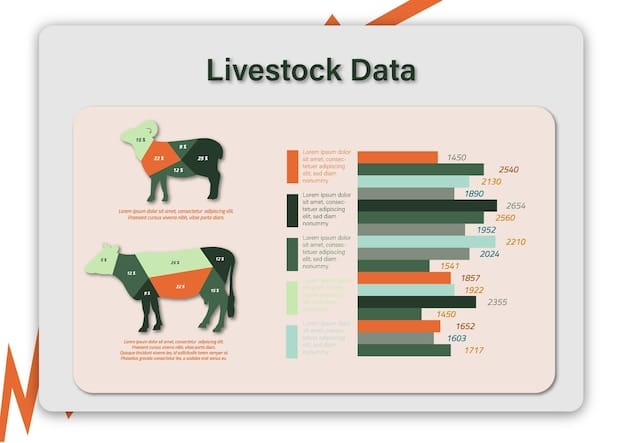Stocks vs. Bonds: A Data-Driven Guide for US Investors

Investing in stocks versus bonds involves distinct risk and reward profiles, with stocks typically offering higher growth potential at greater risk, while bonds provide more stability but lower returns, making the choice dependent on an investor’s risk tolerance, financial goals, and time horizon.
Deciding where to allocate your capital is a fundamental question for any investor. The classic dilemma: **investing in stocks vs. bonds**. Let’s dive into a data-driven comparison tailored for personal finance growth in the US market.
Stocks vs. Bonds: Understanding the Basics
Before diving deep, it’s crucial to grasp the fundamental characteristics of stocks and bonds. This understanding provides a solid foundation for making informed investment decisions.
What are Stocks?
Stocks represent ownership in a company. When you buy stock, you become a shareholder, entitled to a portion of the company’s assets and earnings. Stocks are generally considered higher-risk investments.
What are Bonds?
Bonds, on the other hand, are essentially loans you make to a company or government. In return, the issuer promises to pay you a specified interest rate (coupon) over a set period and return the principal upon maturity. Bonds are typically viewed as lower-risk investments.
Here’s a breakdown of key differences:
- Risk Level: Stocks are riskier due to price volatility, while bonds are generally more stable.
- Potential Returns: Stocks have the potential for higher returns, but also greater losses; bonds offer more predictable, but generally lower, returns.
- Income vs. Growth: Bonds are primarily income-generating, while stocks can offer both income (dividends) and growth.
- Investment Horizon: Stocks are often better suited for long-term investing, while bonds can be suitable for short- to medium-term goals.

Understanding these differences is essential for aligning your investments with your financial goals and risk tolerance. The optimal allocation between stocks and bonds will depend on your personal circumstances.
Historical Performance: A Data-Driven Look
Analyzing historical performance is crucial for understanding the potential risks and rewards associated with stocks and bonds. Past performance is not a guarantee of future results, but it offers valuable insights.
Stock Market Performance
Historically, the stock market has delivered higher returns than the bond market. However, it has also experienced periods of significant volatility, including market crashes and corrections. For example, the S&P 500 has averaged around 10-12% annual returns over the long term, but this includes years with substantial losses.
Bond Market Performance
Bonds, in contrast, have offered more stable returns with lower volatility. The Bloomberg Barclays US Aggregate Bond Index, a broad measure of the US bond market, has historically delivered returns in the range of 3-5% annually. Bonds tend to perform well during economic downturns when investors seek safer assets.
Here’s a comparative perspective:
- Long-Term Returns: Stocks have generally outperformed bonds over long periods (e.g., 20+ years).
- Short-Term Volatility: Bonds have shown less volatility and smaller losses during market downturns.
- Inflation Hedge: Stocks can potentially act as a better hedge against inflation due to their growth potential.
- Deflation Hedge: Bonds, particularly Treasury bonds, often perform well during deflationary periods.
Looking at historical data helps investors understand the trade-offs between risk and return. While stocks offer the potential for higher growth, bonds provide stability and downside protection.
Risk Assessment: Understanding Your Tolerance
Before making any investment decisions, it’s essential to assess your risk tolerance. This is a crucial step in ensuring that your investment portfolio aligns with your comfort level and financial goals.
Factors Influencing Risk Tolerance
Several factors influence an individual’s risk tolerance, including age, financial goals, time horizon, and personal circumstances. Younger investors with longer time horizons may be more comfortable taking on more risk, while older investors approaching retirement may prefer more conservative investments.
Assessing Your Risk Profile
Consider these questions to gauge your risk tolerance:
- How would you react to a significant market downturn (e.g., 20-30% loss)?
- What are your financial goals (e.g., retirement, buying a home)?
- What is your time horizon for achieving these goals?
- What is your current financial situation (e.g., income, debt, savings)?
Aligning Investments with Risk Tolerance
Once you understand your risk tolerance, you can allocate your investments accordingly. A conservative investor might allocate a larger portion of their portfolio to bonds, while an aggressive investor might favor stocks.
By carefully assessing your risk tolerance, you can create an investment portfolio that aligns with your needs and provides the best chance of achieving your financial goals.
Investment Strategies: Tailoring Your Portfolio
The optimal investment strategy depends on individual circumstances, risk tolerance, and financial goals. There are several approaches to consider when building a portfolio with stocks and bonds.

Asset Allocation
Asset allocation is the process of dividing your investment portfolio among different asset classes, such as stocks, bonds, and cash. A common rule of thumb is the “100 minus your age” rule, which suggests that the percentage of your portfolio allocated to stocks should be 100 minus your age. The remainder should be allocated to bonds.
Diversification
Diversification is essential for managing risk. By investing in a variety of stocks and bonds across different sectors and industries, you can reduce the impact of any single investment on your overall portfolio.
Rebalancing
Rebalancing involves periodically adjusting your portfolio to maintain your desired asset allocation. This may involve selling some assets that have performed well and buying others that have underperformed. Rebalancing helps you stay on track with your investment goals and manage risk.
Consider these popular strategies:
- Target-Date Funds: These funds automatically adjust their asset allocation over time to become more conservative as you approach your target retirement date.
- Index Funds and ETFs: These passively managed funds track a specific market index, providing broad diversification at low cost.
- Robo-Advisors: These platforms offer automated investment management services based on your risk tolerance and financial goals.
By carefully considering your investment strategy and tailoring your portfolio to your specific needs, you can increase your chances of achieving long-term financial success.
The Role of Bonds in a Rising Interest Rate Environment
Understanding how rising interest rates affect bond investments is crucial, especially in the current economic climate. Interest rate changes can significantly impact bond values and overall portfolio performance.
Bond Prices and Interest Rates
Bond prices and interest rates have an inverse relationship. When interest rates rise, bond prices generally fall, and vice versa. This is because newly issued bonds will offer higher interest rates to attract investors, making older bonds with lower rates less attractive.
Strategies for Managing Interest Rate Risk
Here are some strategies for managing interest rate risk in a rising rate environment:
- Short-Term Bonds: Investing in short-term bonds can help reduce interest rate risk, as their prices are less sensitive to interest rate changes.
- Floating Rate Bonds: These bonds have interest rates that adjust periodically based on a benchmark interest rate, providing protection against rising rates.
- Bond Ladders: A bond ladder involves staggering bond maturities over time, which can help to mitigate interest rate risk.
Impact on Stocks
Rising interest rates can also impact the stock market. Higher rates can lead to increased borrowing costs for companies, potentially slowing down economic growth and impacting corporate earnings. This can lead to lower stock valuations.
By understanding the dynamics of interest rates and their impact on both bonds and stocks, investors can make more informed decisions and better manage their portfolios in a changing economic environment.
Making the Decision: Stocks or Bonds?
Ultimately, the decision to invest in stocks versus bonds is a personal one. There is no one-size-fits-all answer. Evaluating your unique situation is crucial for making the right choices.
Consider Your Goals
Are you saving for retirement, a down payment on a house, or another long-term goal? Different goals have different time horizons and require different levels of risk. For long-term goals, stocks may be more appropriate, while short-term goals may be better suited for bonds.
Evaluate Your Risk Tolerance
How comfortable are you with the possibility of losing money? If you are risk-averse, you may want to allocate a larger portion of your portfolio to bonds. If you are comfortable with risk, you may prefer stocks.
Seek Professional Advice
Consider consulting with a financial advisor who can help you assess your financial situation, understand your risk tolerance, and develop an investment strategy that aligns with your goals. A professional can provide personalized guidance and help you make informed decisions.
Remember these key takeaways:
- Stocks: Higher potential returns, higher risk, suitable for long-term goals.
- Bonds: Lower potential returns, lower risk, suitable for short- to medium-term goals.
- Diversification: Essential for managing risk.
- Rebalancing: Helps maintain your desired asset allocation.
By carefully considering your goals, risk tolerance, and investment strategy, you can make informed decisions about whether to invest in stocks or bonds and create a portfolio that helps you achieve your financial objectives.
| Key Point | Brief Description |
|---|---|
| 📈 Stocks | Higher risk, potential for higher returns, ownership in a company. |
| 🛡️ Bonds | Lower risk, more stable returns, loan to a company or government. |
| ⚖️ Risk Tolerance | Assess your comfort level with risk to guide your investment choices. |
| 🎯 Goals | Align investments with financial goals (retirement, home purchase, etc.). |
FAQ
▼
Stocks represent ownership in a company and offer higher potential returns but carry more risk, while bonds are loans to entities with lower but more stable returns.
▼
Higher risk tolerance may favor stocks due to their growth potential, whereas lower risk tolerance typically leads to a larger allocation to bonds for stability.
▼
Diversification helps mitigate risk by spreading investments across various stocks and bonds, reducing the impact of any single investment’s performance on the overall portfolio.
▼
Rising interest rates generally cause bond prices to decrease, as newly issued bonds offer higher yields, making existing lower-yield bonds less attractive to investors.
▼
Rebalancing ensures your portfolio maintains its desired asset allocation over time, selling assets that have grown and buying those that have lagged to stay aligned with your risk profile.
Conclusion
The decision of whether to invest in stocks or bonds requires careful consideration of your financial goals, risk tolerance, and time horizon. Stocks offer the potential for higher returns but come with greater risk, while bonds provide stability with lower returns. Diversification, asset allocation, and regular rebalancing are essential components of a well-rounded investment strategy. Seeking professional advice can also help tailor a portfolio that meets your specific needs and optimizes your financial growth.





